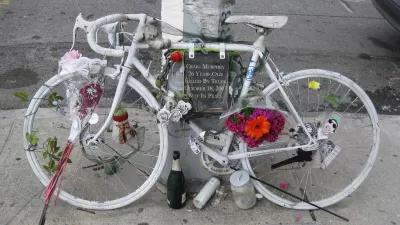The National Highway Traffic Safety Administration (NHTSA) released preliminary fatality estimates for 2015. Deaths jumped by 2,525, an increase of 7.7 percent over 2014. Pedestrians and bicyclists saw the biggest increases.

"If these projections are realized, fatalities will be at the highest level since 2008, when 37,423 fatalities were reported," states the summary of the report (link below).
"NHTSA’s Fatal Analysis Reporting System (FARS) figures for 2014 show 32,675 people died in motor vehicle crashes in 2014, a 0.1-percent decrease from the previous year," states their November 2015 press release (also posted here.)
"As the economy has improved and gas prices have fallen, more Americans are driving more miles,” said NHTSA Administrator Dr. Mark Rosekind in the agency's press release.
“But that only explains part of the increase," he added. "Ninety-four percent of crashes can be tied back to a human choice or error," which is why the agency shuns the use of the word 'accidents' to describe how over 35,000 Americans lost their lives.
Rising deaths, rising vehicle miles traveled (VMT): A correlation?
"With more driving comes a lot more deaths on the nation's roads," Planetizen editor James Brasuell commented on the February report from NHTSA. "The question is why traffic deaths increase at a greater rate than vehicle miles traveled."
Deaths rose by 7.7 percent last year compared to 2014, but VMT increased by 3.5 percent, so clearly it's not just a question of Americans driving more due to lower gas prices and an improving economy.
Another way to count fatalities is per 100 million VMT.
"The fatality rate for 2015 increased to 1.12 fatalities per 100 million VMT, up from 1.08 fatalities per 100 million VMT in 2014," states the report summary. By comparison, the death rate in 2008, the prior record for fatalities, was 1.26, and in 2005, 1.46.
Risky behavior
“We are analyzing the data to determine what factors contributed to the increase in fatalities and at the same time, we are aggressively testing new safety technologies, new ways to improve driver behavior, and new ways to analyze the data we have, as we work with the entire road safety community to take this challenge head-on," stated Rosekind.
The agency is looking at "behavioral challenges including drunk, drugged, distracted and drowsy driving; speeding; failure to use safety features such as seat belts and child seats; and new initiatives to protect vulnerable road users such as pedestrians and cyclists."
Pedestrians and Bicyclists continue to see biggest increase in fatalities
While driver deaths increased by 6 percent, bicyclists increased by over twice that rate, 13 percent. Pedestrian deaths jumped 10 percent, followed by motorcyclists at 9 percent.
In 2014, bicyclist fatalities fell 2.3 percent to 726 while pedestrian fatalities increased 3.1 percent to 4,884 compared to 2013.
For details on the NHTSA report, see the four-page statistical summary: "Early Estimate of Motor Vehicle Traffic Fatalities in 2015 Summary," July 2016 [PDF].
Correspondent's notes on related Planetizen posts:
- The National Safety Council, a nonprofit but nongovernmental organization, counts off road fatalities as well. Their preliminary estimate for 2015, released last February, was 38,300 deaths. The increase was was 8 percent (compared to NHTSA's 7.7 percent).
- The prior NHTSA report, also released in February, revealed that "traffic related deaths are up 11.3 percent for the first nine months of 2015."
- Pedestrian deaths were estimated to have increased 10 percent in 2015 (same as July's NHTSA report) by the Governors Highway Safety Association (GHSA) in March and provides more details on pedestrian fatalities than NHTSA.
- Studies on bicycle injuries and fatalities: Journal of the American Medical Association, 1998-2013 (September 2015)
- Bicycle fatalities, 1975–2012, U.S. Centers for Disease Control and Prevention (August 2015)
- A controversial GHSA bicycle fatalities report, 2010-2012 (November 2014 and October 2014)

Alabama: Trump Terminates Settlements for Black Communities Harmed By Raw Sewage
Trump deemed the landmark civil rights agreement “illegal DEI and environmental justice policy.”

Planetizen Federal Action Tracker
A weekly monitor of how Trump’s orders and actions are impacting planners and planning in America.

How Atlanta Built 7,000 Housing Units in 3 Years
The city’s comprehensive, neighborhood-focused housing strategy focuses on identifying properties and land that can be repurposed for housing and encouraging development in underserved neighborhoods.

In Both Crashes and Crime, Public Transportation is Far Safer than Driving
Contrary to popular assumptions, public transportation has far lower crash and crime rates than automobile travel. For safer communities, improve and encourage transit travel.

Report: Zoning Reforms Should Complement Nashville’s Ambitious Transit Plan
Without reform, restrictive zoning codes will limit the impact of the city’s planned transit expansion and could exclude some of the residents who depend on transit the most.

Judge Orders Release of Frozen IRA, IIJA Funding
The decision is a victory for environmental groups who charged that freezing funds for critical infrastructure and disaster response programs caused “real and irreparable harm” to communities.
Urban Design for Planners 1: Software Tools
This six-course series explores essential urban design concepts using open source software and equips planners with the tools they need to participate fully in the urban design process.
Planning for Universal Design
Learn the tools for implementing Universal Design in planning regulations.
Caltrans
Smith Gee Studio
Institute for Housing and Urban Development Studies (IHS)
City of Grandview
Harvard GSD Executive Education
Toledo-Lucas County Plan Commissions
Salt Lake City
NYU Wagner Graduate School of Public Service




























